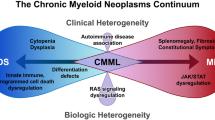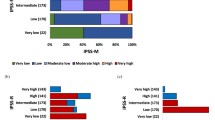Abstract
We evaluated the prognostic relevance of several clinical and laboratory parameters in 226 Mayo Clinic patients with chronic myelomonocytic leukemia (CMML): 152 (67%) males and median age 71 years. At a median follow-up of 15 months, 166 (73%) deaths and 33 (14.5%) leukemic transformations were documented. In univariate analysis, significant risk factors for survival included anemia, thrombocytopenia, increased levels of white blood cells, absolute neutrophils, absolute monocyte count (AMC), absolute lymphocytes, peripheral blood and bone marrow blasts, and presence of circulating immature myeloid cells (IMCs). Spliceosome component (P=0.4) and ASXL1 mutations (P=0.37) had no impact survival. On multivariable analysis, increased AMC (>10 × 109/l, relative risk (RR) 2.5, 95% confidence interval (CI) 1.7–3.8), presence of circulating IMC (RR 2.0, 95% CI 1.4–2.7), decreased hemoglobin (<10 g/dl, RR 1.6, 99% CI 1.2–2.2) and decreased platelet count (<100 × 109/l, RR 1.4, 99% CI 1.0–1.9) remained significant. Using these four risk factors, a new prognostic model for overall (high risk, RR 4.4, 95% CI 2.9–6.7; intermediate risk, RR 2.0, 95% CI 1.4–2.9) and leukemia-free survival (high risk, RR 4.9, 95% CI 1.9–12.8; intermediate risk, RR 2.6, 95% CI 1.1–5.9) performed better than other conventional risk models and was validated in an independent cohort of 268 CMML patients.
This is a preview of subscription content, access via your institution
Access options
Subscribe to this journal
Receive 12 print issues and online access
$259.00 per year
only $21.58 per issue
Buy this article
- Purchase on Springer Link
- Instant access to full article PDF
Prices may be subject to local taxes which are calculated during checkout


Similar content being viewed by others
References
Patnaik MM, Lasho TL, Finke CM, Hanson CA, Hodnefield JM, Knudson RA et al. Spliceosome mutations involving SRSF2, SF3B1, and U2AF35 in chronic myelomonocytic leukemia: prevalence, clinical correlates, and prognostic relevance. Am J Hematol 2012; 88: 201–206.
Germing U, Kundgen A, Gattermann N . Risk assessment in chronic myelomonocytic leukemia (CMML). Leuk Lymphoma 2004; 45: 1311–1318.
Mufti GJ, Stevens JR, Oscier DG, Hamblin TJ, Machin D . Myelodysplastic syndromes: a scoring system with prognostic significance. Br J Haematol 1985; 59: 425–433.
Greenberg P, Cox C, LeBeau MM, Fenaux P, Morel P, Sanz G et al. International scoring system for evaluating prognosis in myelodysplastic syndromes. Blood 1997; 89: 2079–2088.
Morel P, Hebbar M, Lai JL, Duhamel A, Preudhomme C, Wattel E et al. Cytogenetic analysis has strong independent prognostic value in de novo myelodysplastic syndromes and can be incorporated in a new scoring system: a report on 408 cases. Leukemia 1993; 7: 1315–1323.
Onida F, Kantarjian HM, Smith TL, Ball G, Keating MJ, Estey EH et al. Prognostic factors and scoring systems in chronic myelomonocytic leukemia: a retrospective analysis of 213 patients. Blood 2002; 99: 840–849.
Germing U, Strupp C, Aivado M, Gattermann N . New prognostic parameters for chronic myelomonocytic leukemia. Blood 2002; 100: 731–732,, author reply 732–733.
Such E, Cervera J, Costa D, Sole F, Vallespi T, Luno E et al. Cytogenetic risk stratification in chronic myelomonocytic leukemia. Haematologica 2011; 96: 375–383.
Kantarjian H, O’Brien S, Ravandi F, Cortes J, Shan J, Bennett JM et al. Proposal for a new risk model in myelodysplastic syndrome that accounts for events not considered in the original International Prognostic Scoring System. Cancer 2008; 113: 1351–1361.
Wilcox RA, Ristow K, Habermann TM, Inwards DJ, Micallef IN, Johnston PB et al. The absolute monocyte and lymphocyte prognostic score predicts survival and identifies high-risk patients in diffuse large-B-cell lymphoma. Leukemia 2011; 25: 1502–1509.
Breems DA, Van Putten WL, De Greef GE, Van Zelderen-Bhola SL, Gerssen-Schoorl KB, Mellink CH et al. Monosomal karyotype in acute myeloid leukemia: a better indicator of poor prognosis than a complex karyotype. J Clin Oncol 2008; 26: 4791–4797.
Abdel-Wahab O, Kilpivaara O, Patel J, Busque L, Levine RL . The most commonly reported variant in ASXL1 (c.1934dupG;p.Gly646TrpfsX12) is not a somatic alteration. Leukemia 2010; 24: 1656–1657.
Boultwood J, Perry J, Pellagatti A, Fernandez-Mercado M, Fernandez-Santamaria C, Calasanz MJ et al. Frequent mutation of the polycomb-associated gene ASXL1 in the myelodysplastic syndromes and in acute myeloid leukemia. Leukemia 2010; 24: 1062–1065.
Papaemmanuil E, Cazzola M, Boultwood J, Malcovati L, Vyas P, Bowen D et al. Somatic SF3B1 mutation in myelodysplasia with ring sideroblasts. N Engl J Med 2011; 365: 1384–1395.
Yoshida K, Sanada M, Shiraishi Y, Nowak D, Nagata Y, Yamamoto R et al. Frequent pathway mutations of splicing machinery in myelodysplasia. Nature 2011; 478: 64–69.
Carbuccia N, Murati A, Trouplin V, Brecqueville M, Adelaide J, Rey J et al. Mutations of ASXL1 gene in myeloproliferative neoplasms. Leukemia 2009; 23: 2183–2186.
Gelsi-Boyer V, Trouplin V, Adelaide J, Bonansea J, Cervera N, Carbuccia N et al. Mutations of polycomb-associated gene ASXL1 in myelodysplastic syndromes and chronic myelomonocytic leukaemia. Br J Haematol 2009; 145: 788–800.
Patnaik MM, Lasho TL, Hodnefield JM, Knudson RA, Ketterling RP, Garcia-Manero G et al. SF3B1 mutations are prevalent in myelodysplastic syndromes with ring sideroblasts but do not hold independent prognostic value. Blood 2012; 119: 569–572.
Lasho TL, Jimma T, Finke CM, Patnaik M, Hanson CA, Ketterling RP et al. SRSF2 mutations in primary myelofibrosis: significant clustering with IDH mutations and independent association with inferior overall and leukemia-free survival. Blood 2012; 120: 4168–4171.
Abdel-Wahab O, Pardanani A, Patel J, Wadleigh M, Lasho T, Heguy A et al. Concomitant analysis of EZH2 and ASXL1 mutations in myelofibrosis, chronic myelomonocytic leukemia and blast-phase myeloproliferative neoplasms. Leukemia 2011; 25: 1200–1202.
Greenberg PL, Tuechler H, Schanz J, Sanz G, Garcia-Manero G, Sole F et al. Revised International Prognostic Scoring System for myelodysplastic syndromes. Blood 2012; 120: 2454–2465.
Porrata LF, Ristow K, Habermann TM, Ozsan N, Dogan A, Macon W et al. Absolute monocyte/lymphocyte count prognostic score is independent of immunohistochemically determined cell of origin in predicting survival in diffuse large B-cell lymphoma. Leuk Lymphoma 2012; 53: 2159–2165.
Patnaik MM, Hanson CA, Hodnefield JM, Knudson R, Van Dyke DL, Tefferi A . Monosomal karyotype in myelodysplastic syndromes, with or without monosomy 7 or 5, is prognostically worse than an otherwise complex karyotype. Leukemia 2011; 25: 266–270.
Tefferi A . Novel mutations and their functional and clinical relevance in myeloproliferative neoplasms: JAK2, MPL, TET2, ASXL1, CBL, IDH and IKZF1. Leukemia 2010; 24: 1128–1138.
Gelsi-Boyer V, Brecqueville M, Devillier R, Murati A, Mozziconacci MJ, Birnbaum D . Mutations in ASXL1 are associated with poor prognosis across the spectrum of malignant myeloid diseases. J Hematol Oncol 2012; 5: 12.
Acknowledgements
Current study is supported in part by grants from the ‘Myeloproliferative Disorders Foundation, Chicago, IL, USA’ and ‘The Henry J. Predolin Foundation for Research in Leukemia, Mayo Clinic, Rochester, MN, USA’.
Author information
Authors and Affiliations
Corresponding author
Ethics declarations
Competing interests
The authors declare no conflict of interest.
Additional information
Supplementary Information accompanies this paper on the Leukemia website
Rights and permissions
About this article
Cite this article
Patnaik, M., Padron, E., LaBorde, R. et al. Mayo prognostic model for WHO-defined chronic myelomonocytic leukemia: ASXL1 and spliceosome component mutations and outcomes. Leukemia 27, 1504–1510 (2013). https://doi.org/10.1038/leu.2013.88
Received:
Accepted:
Published:
Issue Date:
DOI: https://doi.org/10.1038/leu.2013.88
Keywords
This article is cited by
-
Influence of co-mutational patterns in disease phenotype and clinical outcomes of chronic myelomonocytic leukemia
Leukemia (2024)
-
Proposals for Clinical Trials in Chronic Myelomonocytic Leukemia
Current Treatment Options in Oncology (2023)
-
Significance of cardiovascular comorbidity in patients with chronic myelomonocytic leukemia
Wiener Medizinische Wochenschrift (2023)
-
Significance of reduced renal function in patients with chronic myelomonocytic leukemia
Wiener Medizinische Wochenschrift (2023)
-
Significance of C-reactive protein in patients with chronic myelomonocytic leukemia
Wiener Medizinische Wochenschrift (2023)



